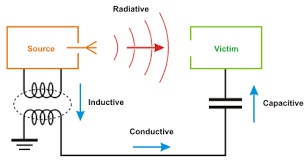Types of Components Used in PCB and their explanations.
In
recent years, semiconductor packaging has evolved with an increased demand for
greater functionality, smaller size, and added utility. A modern PCBA design
has two main methods for mounting components onto a PCB: Through-Hole
Mounting and Surface Mounting.
Through-Hole Components
Through-Hole Mounting (THM):
Through-hole
mounting is the process by which component leads are placed into drilled holes
on a bare PCB. The process was standard practice until the rise of surface
mount technology (SMT) in the 1980s, at which time it was expected to
completely phase out through-hole. Yet, despite a severe drop in popularity
over the years, through-hole technology has proven resilient in the age of SMT,
offering a number of advantages and niche applications: namely, reliability.
Through-hole
components are best used for high-reliability products that require stronger
connections between layers. Whereas SMT components are secured only by solder
on the surface of the board, through-hole component leads run through the
board, allowing the components to withstand more environmental stress. This is
why through-hole technology is commonly used in military and aerospace products
that may experience extreme accelerations, collisions, or high temperatures.
Through-hole technology is also useful in test and prototyping applications
that sometimes require manual adjustments and replacements.
Overall,
through-hole’s complete disappearance from PCB assembly is a wide
misconception. Barring the above uses for through-hole technology, one should
always keep in mind the factors of availability and cost. Not all components
are available as SMD packages, and some through-hole components are less
expensive.
However,
that doesn’t negate that fact that, in a modern assembly facility, through-hole
is considered a secondary operation.
Axial
vs. Radial Lead Components
There
are two types of through-hole components:Axial and Radial lead components.
Axial leads run through a component in a straight line ("axially"),
with each end of the lead wire exiting the component on either end. Both ends
are then placed through two separate holes in the board, allowing the component
to fit closer, flatter fit. Radial lead components, on the other hand, protrude
from the board, as its leads are located on one side of the component.
Both
through-hole component types are "twin" lead components, and both
have their distinct advantages. While axial lead components are used for their
snugness to the board, radial leads occupy less surface area, making them
better for high density boards. Generally, axial lead configuration may come in
the form of carbon resistors, electrolytic capacitors, fuses, and
light-emitting diodes (LEDs). Radial lead components are available as ceramic
disk capacitors.
Advantages: THM
provides stronger mechanical bonds than SMT, making through-hole ideal for
components that might undergo mechanical stress, such as connectors or
transformers. Good for test and prototyping.
Disadvantages: On the
bare PCB side, THM requires the drilling holes, which is expensive and
time consuming. THM also limits the available routing area on any multilayer
boards, because the drilled holes must pass through all the PCB’s layers. On
the assembly side, component placement rates for THM are a fraction of surface
mount placement rates, making THM prohibitively expensive. Further, THM
requires the use of wave, selective, or
hand-soldering techniques, which are much less reliable and repeatable than
reflow ovens used for surface mount. Most of all, through-hole technology
requires soldering on both sides of the board, as opposed to surface-mounts,
which only -- for the most part -- require attention to one side of the
board.
Surface Mount Technology (SMT):
SMT the
process by which components are mounted directly onto the surface of the PCB.
Known originally as “planar mounting,” the method was developed in the 1960s
and has grown increasingly popular since the 1980s. Nowadays, virtually all
electronic hardware is manufactured using SMT. It has become essential to PCB
design and manufacturing, having improved the quality and performance of PCBs
overall, and has reduced the costs of processing and handling greatly.
The key
differences between SMT and through-hole mounting are
(a) SMT does not require
holes to be drilled through a PCB,
(b) SMT components are much smaller, and
(c)
SMT components can be mounted on both side of the board.
The ability to fit a
high number of small components on a PCB has allowed for much denser, higher
performing, and smaller PCBs.
Through-hole
component leads, which run through the board and connect a board’s layers, have
been replaced by "vias" -- small components which allow a conductive
connection between the different layers of a PCB, and which essentially act as
through-hole leads. Some surface mount components like BGAs are higher
performing components with shorter leads and more interconnection pins that
allow for higher speeds.
There are lot of things on this topic which i am going to post on my next Article.
So keep Reading my Article and Enjoy Reading it.
Thanks,
Ruby.








SMT assembly,
ReplyDeleteWe are really grateful for your blog post. You will find a lot of approaches after visiting your post. I was exactly searching for. Thanks for such post and please keep it up. Great work.